Adventures in Dystopia
A rich patchwork of global perspectives provides a dizzying bird’s-eye view of class divisions.
Adventures in Dystopia is a patchwork collection of experiences by loosely connected characters set in various developing countries. Each character of focus knows of at least one other, though these connections aren’t always initially clear. This largely realistic study of people and culture illustrates the extent of globalization, how interconnected the world has become, and how even worldly people can retain provincial prejudices.
In Washington, an official from the World Bank angles for a promotion. In Colombia, a taxi driver robs tourists. In Côte d’Ivoire, a custody battle tears a family apart. At the heart of the book, a naive young missionary travels to India to perform Christian outreach, only to be unwittingly used by two upwardly mobile Indians to sponsor an Internet café.
The theme of each plot varies according to the regional priorities of each character, but it usually ties back to economic mobility. From the World Bank official to the Colombian taxi driver, each character feels that he or she deserves a better place in the hierarchy, often because of priorities that don’t make sense within the broader global context. The World Bank official, for instance, is an expert on global poverty but can’t stand working with the poor.
For the most part, characters are very well rounded. In the acknowledgments, the author indicates that they are all somewhat based on people he knows, which accounts for the diversity of backstories and the realistic details of each character’s behavior. A few personae do verge dangerously close to caricature, particularly Kelly Singer, the enthusiastic missionary blogger. This character often transcends naïveté and continues into implausible ignorance. This is particularly true as Kelly consistently waxes optimistic about the mission, even when she fails to convert a single Hindu to Christianity.
Adventures in Dystopia rambles a great deal in its effort to accurately depict the lives of its characters, but the settings in which each character exists are so disparate that it is sometimes jarring to switch between them. The global perspective, however, is well accomplished and provides a dizzying bird’s-eye view of class divisions in multiple cultural climates. Wealth and poverty are major themes here, and watching characters of different socioeconomic situations interact is fascinating. The original intent of this piece might have been to highlight global poverty issues, but it has accomplished much more by demonstrating the interconnectedness between characters from so many different walks of life.
Structurally, this book presents the impression that the threads of the tale, each basically separate and interspersed throughout the text, will eventually weave together, but the result is less of a weave and more of a continuation of fairly isolated threads. The arc of each story parallels the others, all resolutions occurring at about the same time, and the author deserves credit for coordinating such tricky timing.
It is easy to get lost in the settings depicted in this book. It is an interesting and worthwhile read for anyone interested in globalization or the developing world.
Reviewed by
Anna Call
Disclosure: This article is not an endorsement, but a review. The publisher of this book provided free copies of the book and paid a small fee to have their book reviewed by a professional reviewer. Foreword Reviews and Clarion Reviews make no guarantee that the publisher will receive a positive review. Foreword Magazine, Inc. is disclosing this in accordance with the Federal Trade Commission’s 16 CFR, Part 255.

